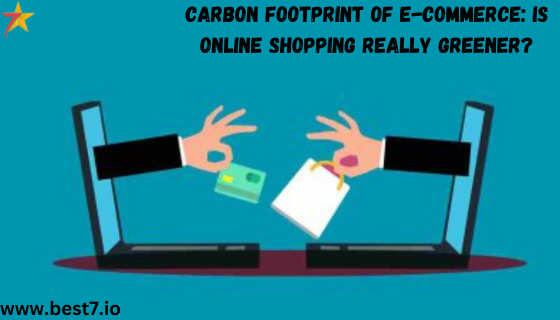
The emergence of e-commerce has brought about massive changes in the form and nature of retail, fostering considerable convenience and globalization of the market. However, with the advent of online shopping, moreover, as it began to take up more and more space, the environmental footprint began to become an issue.
The carbon footprint of e-commerce, which encapsulates shipping emissions, most of the waste from shipped goods, and the vast excess of the production of merchandise, raises concerns about the level of greenness of online shopping.
While some claim that e-commerce results in a smaller carbon footprint than that which is yielded by traditional retail, the likelihood of the situation is rather different.
Projections suggest that e-commerce is likely to remain one of the factors contributing to the considerable environmental damage unless something is changed.
Thus, the following analysis will include an evaluation of the different factors that define the ecological impact of e-commerce and the evidence that online shopping is not as green as it may seem, including the information from the previously conducted case studies and emerging trends.
1. Carbon Emissions from Shipping: How Much Does Online Shopping Really Cost?
Despite the dubious quality of opting for delivery choices in light of the current COVID-19 pandemic, the option of relatively fast delivery remains the defining perk in the minds of most buyers.
However, this tendency has led to a massive rise in shipping emissions, which have become a defining factor in the discussion regarding the greenness of online shopping.
As of the recent case study, the level of emissions continues to grow. In 2020, Urban Freight Lab in Seattle found that nearly 30% of the transportation e-commerce emissions were produced by the following delivery vehicles.
With the overwhelming reliance on quick delivery, the share of traffic produced by them will certainly grow. The possibility of a 25% growth of shipping emissions by 2030.
It is not easy to compare traditional retail and e-commerce in terms of carbon emissions. When online shopping is involved, people no longer need to travel to stores, whereas delivery to one’s home also carries certain carbon costs.
However, the environmental analysis of e-commerce shows that the use of air freight and the delivery of single items with multiple vehicles create a broader carbon footprint than one might imagine. If the current trend continues, air freight could cover up to 40% of e-commerce shipping emissions by 2030.
Efforts are made to make e-commerce’s supply chain more sustainable. Some companies are now investing in electric bikes and delivery vehicles and optimizing delivery routes to reduce fuel use.
By 2035 at the latest, 50% of all e-commerce shipments will be delivered with electric or hybrid vehicles, which will significantly decrease shipment emissions. As the demand for fast delivery increases, these efforts need to be implemented on a larger scale.
2. Hidden Environmental Costs: Packaging Waste
Another challenge regarding the broader environmental costs of e-commerce is packaging waste. While goods are often transported to stores in bulk, e-commerce companies often deliver them as separate parcels, intensifying the use of non-recyclable or multiple-use packaging material.
According to a study conducted in 2021, e-commerce packaging waste takes up 6.2 million tons of global waste, and if the trend continues, it is expected to reach 8.5 million tons by 2028.
Lifecycle analysis of e-commerce packaging indicates the high volume of resources needed during its production and disposal. The use of plastics, bubble wrap, and cardboard leads to heavy deforestation and contributes to air and water pollution, contradicting the view that online shopping is more sustainable.
E-commerce’s waste management is still in the woods: the recycling industry is far from satisfying the growing packaging waste, as by 2030, only 45% of e-commerce packaging waste is likely to be recycled. Eco-friendly e-commerce is likely to result in the extensive use of biodegradables.
E-commerce giants, such as Amazon and IKEA, are already using compostable packaging, which, however, still has a slower decomposition process compared to an orange.
Moreover, by 2030, it is anticipated that 25% of e-commerce packaging will be biodegradable or recyclable. Although eco-friendly e-commerce seems like a giant leap towards more sustainable e-commerce, handling consumer packaging waste is still likely to be a very challenging task, as already in 2020, 67% of consumers became more reliant on online shopping.
3. Comparing E-Commerce and Traditional Retail: A Carbon Footprint Perspective
The question of whether e-commerce is greener than traditional commerce triggers a never-ending discussion. A comparative environmental analysis of the two types of commerce has identified that both e-commerce and traditional commerce have their own carbon emission advantages and disadvantages.
For example, e-commerce allows the customers to stay home and avoid driving to a physical store, but warehouse energy usage, packaging, and delivery result in an overall larger energy use.
A case study of carbon footprint performed in 2019 for traditional retail and e-commerce was compared for six factors: associated transportation, energy consumption, returned goods, secondary packaging, long-term warehouse emissions, and waste.
It was found that online shopping generates 35% more emissions than traditional shopping if fast shipping is employed.
Its data projection for 2030 shows that the carbon footprint of e-commerce will exceed that of traditional shopping unless there are significant changes across the whole supply chain leading to an emission decrease.
Consumer behavior and online shopping features also affect data comparisons. As a result of changes in shopping convenience and behavior, impulse buying and return frequency also increase carbon emissions related to online shopping.
Thus, by 2020, as much as 10% of online shopping’s total emissions will be related to returned goods. The statement concludes that online shopping is greener in certain situations, while e-commerce at the moment has an environmental footprint exceeding that of traditional shopping under standard conditions.
4. Future Projections: Pathways to a More Sustainable E-Commerce Model
Overall, it can be said that companies have to pursue greener practices in order to reduce the negative impact of e-commerce on the natural environment, implementing a wide range of measures aimed at reducing carbon emissions, waste, and pollution. Seven major areas will affect sustainability in the e-commerce sphere in the future:
- Sustainable Packaging Innovations: The use of biodegradable and recyclable packaging materials will be increasingly popular, and by 2035, it is expected to be over 50% among e-commerce. Special technologies used in packaging manufacturing will help to reduce consumption of resources and increase the degree of its recyclability.
- Adoption of Green Logistics: 60% of e-commerce companies by 2030 will deploy green logistics methods, using electric delivery vehicles, optimized delivery routes, and rail transportation for less emission.
- Carbon Offset Programs: 40% of online shopping transactions by 2027 will be related to carbon offset programs, thus enabling total compensation of e-commerce-related emissions.
- Development of Eco-Friendly Warehousing: Warehousing and distribution corporations will increase the role of renewable energy sources. It is expected that by 2028, around 30% of warehouses will operate on solar power or wind power, resulting in a lower e-commerce carbon footprint.
- Promotion of Eco-Conscious Behaviors in Consumers: Consumer awareness regarding the environmental impact of e-commerce will be increasing; by 2025, it is expected that 70% of customers will pay attention to environmental impact while making purchases in e-commerce.
- Lifecycle Analysis and Transparency: Companies will carry out lifecycle analyses to determine obsolete features and potential for improvements in production. Moreover, the results will be used to provide customers with information regarding the carbon footprint of a product. By 2032, it is expected that around 20% of e-commerce products will contain carbon footprint labels.
- Enhancing Waste Management and Recycling: Improved recycling facilities within cities and increased knowledge sharing from companies will improve the level of recycling in the sector. By 2035, it is expected that over 55% of e-commerce packaging waste will be recycled or composted.
These approaches will serve to reduce the carbon footprint of e-commerce. However, they would also demand considerable contributions from all participants, including companies, consumers, and policymakers. It appears that failing to act on the environmental pollution by e-commerce may result in its rapid growth, which would become hazardous for the Earth.












